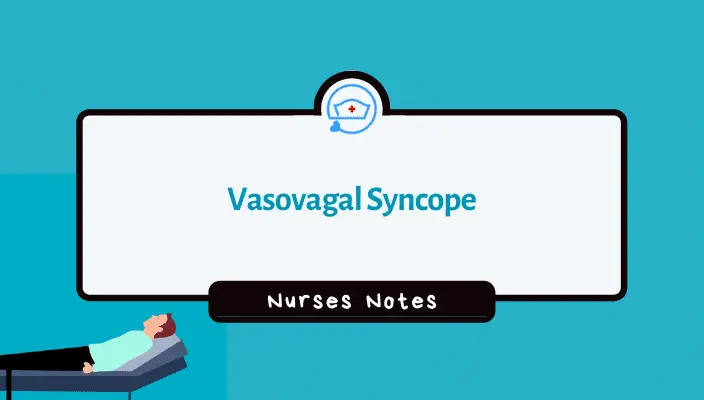Last updated on December 28th, 2023
What is Vasovagal Syncope?
Vasovagal Syncope is the most common type of syncope – faint. It happens as a result of certain triggers. For instance, the sight of blood, stress, severe pain, or intense emotions and phobias.
Generally, there is no serious underlying cause of vasovagal reflex syncope. Although, fainting poses a risk of trauma. Also, the sense of lack of physical control could lead to low self-esteem.
The frequency of vasovagal attacks may vary from once a year to a weekly or even daily basis.
Definition of vasovagal syncope
Vasovagal Syncope is characterized by transient loss of consciousness due to hypotension, peripheral vasodilation, and bradycardia as a result of over-stimulation of the vagus nerve.
Pathophysiology of a vasovagal syncope
Pathophysiology of vasovagal syncope is initiated by stressful, painful, or claustrophobic intense emotions, causing hyper-stimulated vagus nerve.
This leads to peripheral vasodilatation and the pooling of blood in the extremities. As a result, peripheral vascular resistance decreases. Ultimately, causing a sudden drop in blood returning to the heart.
The combination of bradycardia and hypotension reduces the normal blood flow to the brain significantly. This sudden hemodynamic imbalance results in transient loss of consciousness – syncope.
Causes of vasovagal syncope
Cause vasovagal attack include,
- Extreme emotions such as phobias
- The sight of blood
- Excessive heat and dehydration
- Severe pain
- Strenuous exercise
- Standing for long periods
Signs and Symptoms vasovagal syncope
Following are the sign and symptoms of the vasovagal attack.
- Feeling dizziness or lightheadedness
- Skin becomes pale, green, or grey
- Visual disturbances such as blurred vision, tunnel vision
- Dilatation of pupils
- Yawning
- Nausea
- Excessive sweating
- A sudden sensation of feeling hot or cold
- Sudden urge to urinate or defecate
- Sudden jerky or abnormal movements
- Restlessness
Diagnosing vasovagal syncope
Like any other health condition, diagnosing a vasovagal syncope begins with in-depth past medical history along with a thorough physical examination.
Additional investigations include,
- Electrocardiogram
- Echocardiogram
- Exercise stress test
- Blood tests
- Tilt table test
Treatment of vasovagal syncope
The majority of the patients experiencing vasovagal syncope don’t need any treatment because episodes are self-limiting in nature.
But in rare cases, medical or surgical intervention may be needed. For instance, the frequency of recurring vasovagal attacks interferes with the quality of life of the patient.
Pharmacological management include,
- Alpha-1-adrenergic agonists, to increase blood pressure
- Corticosteroids, to help increase the sodium and fluid levels
- Serotonin reuptake inhibitors (SSRIs), to moderate the nervous system response
Surgical intervention includes,
- Inserting an electrical pacemaker to regulate the heartbeat
Nursing Responsibilities
- Take a thorough patient medical and surgical history
- If the patient is likely to have a vasovagal attack, briefly explain the maneuver to prevent a syncopal episode by intensely contracting hands, hands, arms, feet, and legs while releasing the muscles of the belly, bottom, and chest.
- Ensure adequate hydration before the procedure
- Ensure patient take meals adequately
- Closely observe for any signs and symptoms of vasovagal attack during procedures
- Be aware of the most common triggers for a vasovagal reaction such as,
- the sight of blood (Eg. While taking blood sample)
- injections
- watching someone undergo a procedure
- Reassure the patient after the vasovagal attack
Patient education for vasovagal syncope
- Ask the patient to identify and avoid triggers that cause a vasovagal reaction. For example, standing for a long time or the sight of blood.
- Teach the patient maneuvers to prevent the vasovagal attack.
- For instance, crossing legs along with squeezing the muscles of hands and foot to increase peripheral vascular resistance to
- Lie down and elevating foot above heart level to increase blood flow to the brain by gravity
- Sit down and put the head between both knees until the patient feels better.
- Advice to do exercise cautiously
- Advice to talk to consulting doctor regarding discontinuing the medicine like diuretic which could lower blood pressure.
- Advice to eat a high salt diet
- Advice to drinking plenty of fluids
- Avice to wear compression stockings or abdominal binders
Conclusion
In conclusion, vasovagal syncope common faint which usually does not involve any dangerous underlying health problem.
By leg crossing combined with tensing muscles of both extremities can postpone or prevent the vasovagal attack.
Reference
Ignatavicius, D., Workman, M., Blair, M., Rebar, C., & Winkelman, C. (2016). MEDICAL-SURGICAL NURSING: Patient-Centered Collaborative Care (8th ed.). St. Louis: Elsevier, Inc.
Papadakis, M., McPhee, S., & Rabow, M. (2019). CURRENT Medical Diagnosis & Treatment (15th ed.). McGraw-Hill Education.


